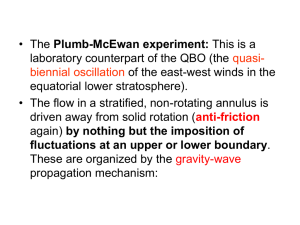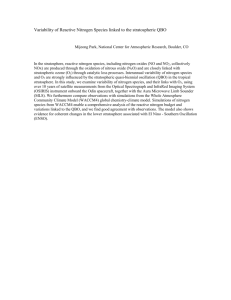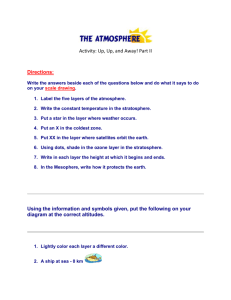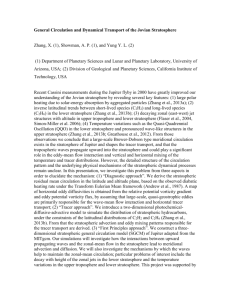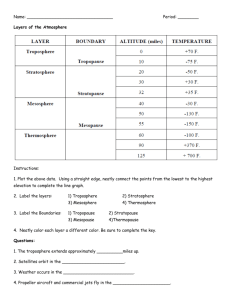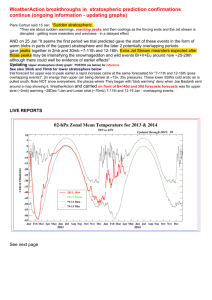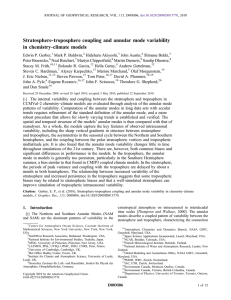The Stratospheric Link Between the Sun and Climate
advertisement
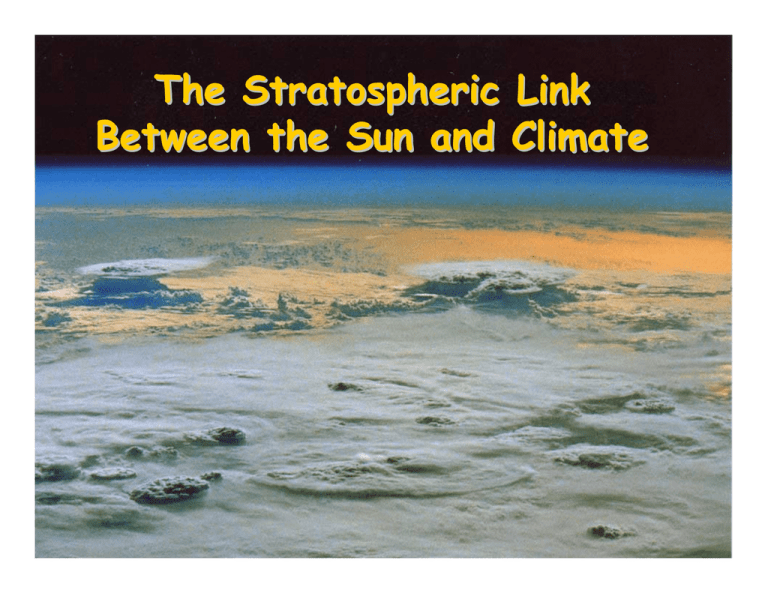
The Stratospheric Link Between the Sun and Climate The Stratospheric Link Between the Sun and Climate Mark P. Baldwin Northwest Research Associates, USA SORCE, 27 October 2004 Overview Climatology of the stratosphere The Quasi-biennial Oscillation (QBO) Effects of tropical oscillations on the extratropics Annular modes, Arctic Oscillation Connection between the stratosphere and surface climate (winter) Speculation on summer vertical coupling The Equatorial Quasi-Biennial Oscillation Wind Anomalies Holton-Tan Effect 500-hPa (mid-troposphere) 500-hPa (mid-troposphere) Lack of observations Solar/Ozone Heating QBO? Solar-QBO-SAO Lack of observations in the equatorial stratosphere Holton-Tan: upper or lower stratosphere? Solar/QBO interaction (Labitzke-van Loon) Solar modulation of the QBO itself A Mechanism for Solar Variability Effects on Surface Climate Mark P. Baldwin Northwest Research Associates Bellevue, WA USA IUGG 9 July, 2003 Northern Annular Mode (NAM) 1000 hPa (Arctic Oscillation) 10 hPa Annular mode patterns are the leading EOF of low-frequency Z variability. Annular mode patterns are similar from Earth’s surface to 50+km. Annular Mode Terminology Arctic Oscillation (AO): At or near Earth’s surface. North Atlantic Oscillation (NAO): Very similar to AO, but more oriented to the Atlantic sector. Northern Annular Mode (NAM): Same as the AO, but can describe higher levels in the atmosphere. The surface NAM is the Arctic Oscillation. Annular mode index. Composite surface maps for high and low AO index. (From Thompson and Wallace, Science 2001) >0.9°C 250-day running mean AM time series. Weak Winds Strong Winds NAM index for 1998–1999. 23 separate levels are used. The lowest level is the AO index. Composites of strong and weak vortex events Select strong events based only on the daily 10-hPa NAM index. Include only strong events. Examine average behavior for the composites. If solar variability can affect the strength of the stratospheric polar vortex, then surface climate will be affected. Time Delay Long timescale 500-hPa (mid-troposphere) Surface pressure anomalies after stratospheric events look like the Arctic Oscillation. During winter changes to the lower stratosphere affect surface climate Summer 500-hPa (mid-troposphere) Labitzke-van Loon “crescent” 500-hPa (mid-troposphere) Volcanoes Induce changes to the atmosphere through volcanic aerosols (radiative effects, ozone depletion) Appear to induce a negative AO anomaly for ~two years Autocorrelation of daily surface AO index (W. Norton, GRL, 2003) ControlModel Run Normal Model with damped stratosphere Without stratospheric variability, the timescale of the surface AO is shorter. In the troposphere the longest timescale occurs during winter. Does this effect depend on the stratosphere, or is it simply an annual cycle? Possible Dynamical Mechanisms Movement of mass within the stratosphere (Dave Thompson) Effect on baroclinic waves/life cycles Effect on planetary-scale waves Wave reflection in the stratosphere Predictability Beyond 10 Days—a role for the stratosphere? Boundary Conditions (SSTs, Snow and Ice, Soil Moisture, etc.) Persistent Phenomena (MJO, QBO, ENSO, etc.) Persistent stratospheric anomalies—can they affect the troposphere? Statistical AO Forecasts Exploit the enhanced timescale of the AO during winter. Predict the average AO during a future time period, such as 10–40 days. Use one or more linear predictors: 1) The present value of the AO 2) The present values of the annular modes at all other levels, including the stratosphere. Cross-validated AO Forecasts Remove one winter at a time; forecast the remaining winter. 150-hPa NAM only during DJF: skill is reduced from 20% to 18%. AO predicts AO: cross-validated skill is 12% Adding the the AO as a second predictor does not improve skill. Lagged MCA between daily 150hPa Z and monthlymean 1000hPa Z beginning 10 days later yields patterns nearly identical to the NAM. NAM Maximum Covariance Analysis (MCA) What are “annular modes?” Not fundamental dynamical quantities Not the solution to any equation Why do they look so similar in the Northern and Southern Hemispheres and in the troposphere & stratosphere? Why does the atmosphere tend to vary in “ring-like” structures? Why not multiple rings? The latitude of the peak in the jet is very different in the stratosphere and troposphere, yet the node in the annular mode pattern is at a similar latitude. Why? How are annular modes related to jets? Why does the effect of stratospheric anomalies look almost exactly like the NAM at 1000 hPa? Can we construct a simple analytic model that produces annular modes? AGU Chapman Conference: “Jets and Annular Structures in Geophysical Fluids” Time: 2005 or 2006 Place: not decided Lead Convener: Walt Robinson Southern Hemisphere surface climate response to ozone depletion Observations and model Springtime ozone loss appears to drive changes in surface climate from late spring to summer. Simulated and observed geopotential height and temperature changes Model results from Gillett & Thompson, 2003 Tropospheric changes Model results from Gillett & Thompson, 2003 A stronger, colder vortex? With increasing GHGs, the modeled stratospheric vortex becomes stronger and colder, and there is a positive AO trend. Shindell et al., [1999] With increasing GHGs, “the model NAO index decreases significantly from 1990 to 2015.” The polar stratosphere becomes warmer. Schnadt and Dameris, [2003] Polar vortex response to 4x CO2 January Temperature Change January U Change • The polar vortex gets weaker and warmer due to enhanced wave driving from the troposphere. • These plots show the response in a 4xCO2 integration - easier to distinguish from noise (from Jamie Kettleborough). Satellite Observations of Tropospheric Temperatures Cooling Warming From Fu et al., Nature, 6 May 2004 Summary Solar/ozone effects in the context of QBO, SAO. Indirect pathway through the stratospheric polar vortex. Changes to the circulation of the lower stratosphere affect surface climate. On climate-change timescales, we do not know how the stratosphere will change, and we do not know how surface climate will be affected. We do not fully understand the dynamics of stratospheretroposphere coupling. Reprints. mark@nwra.com www.nwra.com/baldwin
